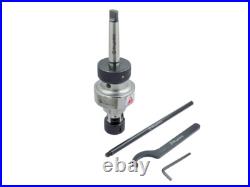2025
Reversible Tapping Attachment M10-M20 Prevents Tap Breakage, Reverse Use


Reversible Tapping Attachment M10- M20 Range II Avoid Tap Breakage II Works on Reverse Mechanism. A reversible tapping attachment on a drilling and milling machine is used to perform tapping operations-where a hole is threaded-on a workpiece. This attachment is designed to thread holes in both directions: forward for cutting threads and reverse for backing out the tap, preventing the tap from breaking due to excessive torque when it binds. Tapping Process & Capacity. The milling machine is equipped with the tapping attachment, which holds the tap and provides the necessary rotation for threading. The machine’s spindle rotates the tap in a forward direction (clockwise) to create threads in the hole. The tapping attachment is designed with a mechanism that allows the tap to reverse rotation automatically once it reaches the bottom of the hole or a set depth. Range of Taps that it can hold M3 to M12. The key feature of the reversible tapping attachment is its ability to reverse the direction of rotation without manual intervention. This is particularly useful to avoid breaking the tap if it gets stuck in the workpiece. Once the tap starts to experience resistance during the cutting process, the attachment automatically switches to a reverse mode to back out the tap, ensuring it does not get damaged or jammed. The feed for the tapping operation is provided either manually or via an automatic feed system. In some cases, the milling machine has a feed that automatically controls the depth of the tap, while other systems might require operator input for depth control. Most tapping attachments come with adjustable depth stops, so the user can set how deep the tap should go into the material. This helps prevent over-tapping or under-tapping. Use of Clutch Mechanism. The clutch in the tapping attachment disengages when the tap reaches the desired depth, allowing for the reversal of the tap’s direction without applying excess torque. Advantages of Reversible Tapping Attachments. Prevention of Tap Breakage. The reversible action ensures that the tap can back out automatically when it meets resistance, preventing tap breakage and reducing the risk of damaging the part. With automatic reversal, the need for manual intervention is eliminated, saving time and increasing overall productivity. The operator does not need to stop the machine to reverse the direction of the tap manually. Since the tap automatically backs out after completing the threading operation, the threads are less likely to be damaged by excessive torque or force. The system is relatively simple to operate, and adjustments can usually be made for different tap sizes and thread pitches. Key Components of a Reversible Tapping Attachment. Spindle: Holds and rotates the tap. Clutch Mechanism: Allows the automatic reverse of the tap’s rotation. Feed Mechanism: Provides movement for the tap during the cutting process. Depth Stop: Adjustable to control the tapping depth. Cooling System: Some attachments feature a built-in cooling system to ensure the tap doesn’t overheat during the operation. Tapping attachments are ideal for use in high-volume production environments where threading is a routine operation. They are used in industries like automotive, aerospace, and general manufacturing for creating threaded holes in metals, plastics, and other materials. In summary, the reversible tapping attachment on a milling machine allows for efficient, reliable, and safe threading of holes, with the ability to automatically reverse the tap to prevent breakage and improve productivity.
Comments Off

